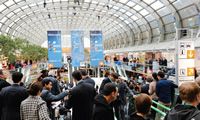This is the first time in the award’s history that press technology in this format has received the coveted award. Overall, however, this is Heidelberg’s 32nd InterTech Technology Award.
When printing mixed forms, the larger the paper format the greater the flexibility in arranging individual repeats. In the past, large-format perfectors had to contend with two limitations — smearing during sheet travel and machine-related restrictions in the arrangement of the mixed forms, since corridors for sheet brakes prevented efficient job pooling and reduced the printable area by up to 6%. Both limitations are now history thanks to Heidelberg’s double gripper technology showcased at drupa 2012.
Since the sheet in the delivery is guided by grippers at both front and rear edges, the sheet guide plate has been eliminated and, with it, the risk of ink buildup and associated scratches. Use of a special brake gripper bar also dispenses with the brake corridors that previously hindered job pooling. Jobs can now be nested over the entire surface of the sheet.
The elimination of brake corridors results in significant cost reduction, not only for web-to-print shops but also for commercial printing. Paper savings of around 50mm across the width of the sheet considerably reduce paper costs.
Precise register accuracy
Motorised paper stretch compensation ensures precise register accuracy. Heidelberg was the first to offer motorised paper stretch compensation for large-format applications when this function was added to Speedmaster XL presses in 2012.
The technology enables a register error caused by paper distortion at the rear edge of the sheet to be compensated automatically from the Prinect Press Centre control station, eliminating the time-consuming process of manually adjusting the impression cylinder circumferentially or laterally by means of clamping bar segments.
This register accuracy is a crucial advantage in the production of mixed forms – by web-to-print suppliers in particular. Mixed forms can easily accommodate up to 100 customer jobs, each demanding perfection, even if, for example, there are negative 8-point fonts at the rear edge of the sheet in 7B format. What’s more, makeready is around ten minutes faster, depending on the machine configuration.
[Ed’s note: Since 1978, InterTech Technology Awards sponsored by PIA (Printing Industries of America) have honoured technologies predicted to have a major impact on the graphic arts and related industries. More than 80% of technologies that have received an award have experienced ongoing commercial success.]









